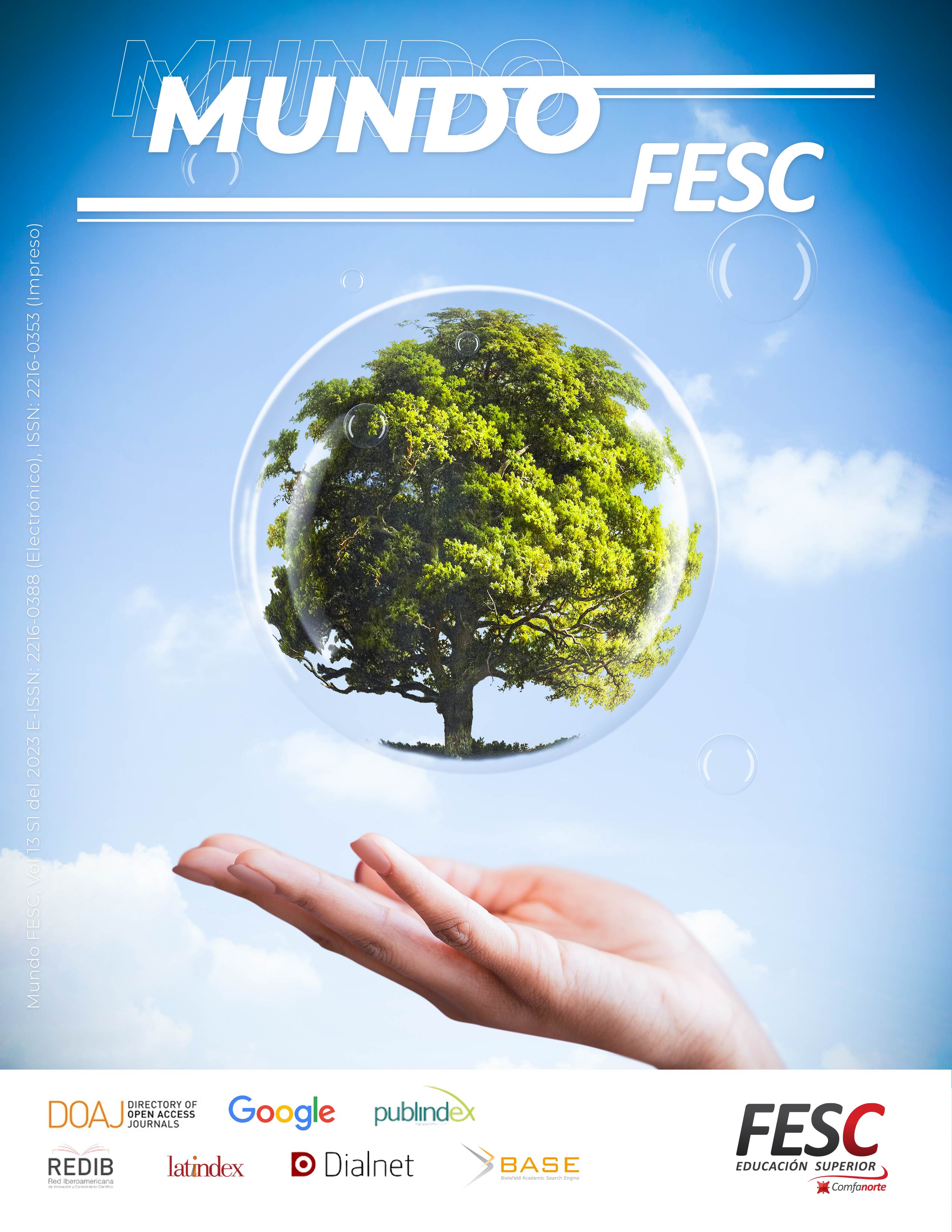Impacto Del Deterioro Vial En La Salud De Los Habitantes De La Carrera 12 Via Terminal De Transporte Aguachica Cesar
DOI:
https://doi.org/10.61799/2216-0388.1727Palabras clave:
Aguas Estancadas, Contaminación Auditiva, Dengue, Material Particulado, Malla VíalResumen
En Aguachica-Cesar existen múltiples problemáticas, entre las que se destacan las producidas por el deterioro de la malla vial y el tráfico de carga pesada dentro del perímetro urbano. En el presente estudió cualitativo se analizó el efecto de las condiciones ambientales del sector de la carrera 12 entre calle 10 y calle 8 aplicando una encuesta a habitantes del sector, en la cual se preguntaba acerca de sintomatología asociada a la exposición a ciertos factores contaminantes. Los resultados mostraron que más del 85% de los encuestados manifestó presentar alguna sintomatología relacionadas con factores de contaminación auditiva, como estrés, insomnio, ansiedad y dolores de cabeza; mientras que más del 90% presenta síntomas asociados a la exposición a material particulado. Por último, más del 90% de los habitantes consultados manifestó haber tenido conocimiento de enfermedades, como el Dengue, Zika, Chikungunya y enfermedades cutáneas producidas por el estancamiento de aguas lluvias.
Descargas
Referencias
[1] R. Al-Tohamy, S. Ali, F. Li, K. Okasha, Y. Mahmoud, T. Elsamahy, H. Jiao, Y. Fu, y J. Sun, “A critical review on the treatment of dye-containing wastewater: Ecotoxicological and health concerns of textile dyes and possible remediation approaches for environmental safety”, Ecotoxicology and Environmental Safety, 231, 113-160, 2022. https://doi.org/10.1016/j.ecoenv.2021.113160 DOI: https://doi.org/10.1016/j.ecoenv.2021.113160
[2] C. Mora, J. Villamizar, y N. Cañas, “Turismo de salud como opción de aumento de la oferta de servicios en San José de Cúcuta”, Revista Visión Internacional, vol 7, no. 1, pp. 46-63. DOI: https://doi.org/10.22463/27111121.3363 DOI: https://doi.org/10.22463/27111121.3363
[3] M. Ramírez, J. Hernández, Z. Nieto, y A. Bravo, “Comprender la salud para atender la vida: insinuaciones pedagógicas que indisciplinan la relación ciencia–saber para transformar los aprendizajes”, Perspectivas, vol. 8, no. S2, pp. 99-109, 2023. DOI: https://doi.org/10.22463/25909215.4606 DOI: https://doi.org/10.22463/25909215.4606
[4] Organizacion Mundial de la Salud, Estadísticas sanitarias mundiales 2024: seguimiento de la salud para los ODS y los objetivos de desarrollo sostenible, Editores Organización Mundial de la Salud, ISBN 9789240094703. 2024. https://www.who.int/publications/i/item/9789240094703 [Acseso dic-12-2024]
[5] Organización Mundial de la Salud. (2020). Estadísticas Sanitarias Mundiales 2020. In OMS, Vol. 1, Issue 2, 2020. https://apps.who.int/iris/bitstream/handle/10665/338072/9789240011953-spa.pdf?sequence=1&isAllowed=y%22 [Acseso dic-19-2024]
[6] M. Riedl, & D. Diaz-Sanchez, “Biology of diesel exhaust effects on respiratory function”, Journal of Allergy and Clinical Immunology, 115(2), 221–228, 2005. https://doi.org/10.1016/j.jaci.2004.11.047 DOI: https://doi.org/10.1016/j.jaci.2004.11.047
[7] R. Valiente, “Colectivos decuidadores comunitarios de la salud mental:Unapoyopsicológicoparapersonasenduelopor la pandemia de COVID−19. Revista Temario Científico 2 (1), pp. 24−38, 2022. DOI: https://doi.org/10.47212/rtcAlinin.1.2.3 DOI: https://doi.org/10.47212/rtcAlinin.1.2.3
[8] C. Zundel, P. Ryan, C. Brokamp, A. Heeter, Y. Huang, J. Strawn, H. & Marusak, “Air pollution, depressive and anxiety disorders, and brain effects: A systematic review”, NeuroToxicology, 93, pp. 272–300, 2022. https://doi.org/10.1016/j.neuro.2022.10.011 DOI: https://doi.org/10.1016/j.neuro.2022.10.011
[9] E. Borroni, A. Pesatori, V. Bollati, M. Buoli, & M. Carugno, M. (2022). Air pollution exposure and depression: A comprehensive updated systematic review and meta-analysis. Environmental Pollution, 292. 2022. https://doi.org/10.1016/j.envpol.2021.118245 DOI: https://doi.org/10.1016/j.envpol.2021.118245
[10] L. Liang, & P. Gong, “Urban and air pollution: a multi-city study of long-term effects of urban landscape patterns on air quality trends”, Scientific Reports, 10(1), 1–13, 2020. https://doi.org/10.1038/s41598-020-74524-9 DOI: https://doi.org/10.1038/s41598-020-74524-9
[11] S. Mayne, J. Mitchell, S. Virudachalam, A. Fiks, & A. Williamson, “Neighborhood environments and sleep among children and adolescents: A systematic review”, Sleep Medicine Reviews, 57, 2021. https://doi.org/10.1016/j.smrv.2021.101465 DOI: https://doi.org/10.1016/j.smrv.2021.101465
[12] A. Fyhri, & G. Aasvang, “Noise, sleep and poor health: Modeling the relationship between road traffic noise and cardiovascular problems”, Science of the Total Environment, 408 (21), 4935–4942, 2010. https://doi.org/10.1016/j.scitotenv.2010.06.057 DOI: https://doi.org/10.1016/j.scitotenv.2010.06.057
[13] S. Du, Y. Liu, J. Liu, J. Zhao, C. Champagne, L. Tong, R. Zhang, F. Zhang, C. Qin, P. Ma, C. Chen, G. Liang, Q. Liu, P. Shi, B. Cazelles, P. Wang, H. Tian, & G. Cheng, G, “Aedes mosquitoes acquire and transmit Zika virus by breeding in contaminated aquatic environments”, Nature Communications, 10(1), 1–11, 2019. https://doi.org/10.1038/s41467-019-09256-0 DOI: https://doi.org/10.1038/s41467-019-09256-0
[14] M. Nieves, Y. Chirinos, R. Godínez, y D. Rojas, “Gnoseología de la flexibilización laboral interna”, En Tendencias en la Investigación Universitaria. Una visión desde Latinoamérica, Chirinos, Y., Ramírez, A., Godínez, R. Barbera, N. y Rojas, D.(2021).(Eds.), https://doi.org/10.47212/tendencias2021vol.xvi.19 DOI: https://doi.org/10.47212/tendencias2021vol.xvi.19
[15] H. Boogaard, A. Patton, R. Atkinson, J. Brook, H. Chang, D. Crouse, J. Fussell, G. Hoek, B. Hoffmann, R. Kappeler, M. Kutlar, M. Ondras, S. Sagiv, E. Samoli, R. Shaikh, A. Smargiassi, A. Szpiro, E. Van Vliet, D. Vienneau, … F. Forastiere, “Long-term exposure to traffic-related air pollution and selected health outcomes: A systematic review and meta-analysis”, Environment International, 164(January), 107-262, 2022. https://doi.org/10.1016/j.envint.2022.107262 DOI: https://doi.org/10.1016/j.envint.2022.107262
[16] J. Verhoeven, Y. Allach, I. Vaartjes, C. Klijn, & F. de Leeuw, “Ambient air pollution and the risk of ischaemic and haemorrhagic stroke”, The Lancet Planetary Health, 5(8), 542–552. 2021. https://doi.org/10.1016/S2542-5196(21)00145-5 DOI: https://doi.org/10.1016/S2542-5196(21)00145-5
[17] M. Beutel, C. Jünger, E. Klein, P. Wild, K. Lackner, M. Blettner, H. Binder, M. Michal, J. Wiltink, E. Brähler, & T. Münzel, “Noise annoyance is associated with depression and anxiety in the general population- the contribution of aircraft noise” PLoS ONE, 11(5), 1–10, 2016. https://doi.org/10.1371/journal.pone.0155357 DOI: https://doi.org/10.1371/journal.pone.0155357
[18] M. Basner, W. Babisch, A. Davis, M. Brink, C. Clark, S. Janssen, & S. Stansfeld, “Auditory and non-auditory effects of noise on health” The Lancet, 383(9925), 1325–1332, 2014. https://doi.org/10.1016/S0140-6736(13)61613-X DOI: https://doi.org/10.1016/S0140-6736(13)61613-X
[19] A. Recio, C. Linares, J. Banegas, & J. Díaz, “Road traffic noise effects on cardiovascular, respiratory, and metabolic health: An integrative model of biological mechanisms”, Environmental Research, 146, 359–370, 2016. https://doi.org/10.1016/j.envres.2015.12.036 DOI: https://doi.org/10.1016/j.envres.2015.12.036
[20] M. Ferrara, & L. De Gennaro, “How much sleep do we need?” Sleep Medicine Reviews, 5(2), 155–179, 2001. https://doi.org/10.1053/smrv.2000.0138 DOI: https://doi.org/10.1053/smrv.2000.0138
[21] L. Jarup et al., “Hypertension and exposure to noise near airports: The HYENA study”, Environmental Health Perspectives, 116(3), 329–333, 2008. https://doi.org/10.1289/ehp.10775 DOI: https://doi.org/10.1289/ehp.10775
[22] V. Stone, H. Johnston, & J. Clift, “Air pollution, ultrafine and nanoparticle toxicology: Cellular and molecular interactions”, IEEE Transactions on Nanobioscience, 6(4), 331–340, 2007. https://doi.org/10.1109/TNB.2007.909005 DOI: https://doi.org/10.1109/TNB.2007.909005
[23] R. Hashemi Habybabady, H. Nasibi Sis, F. Paridokht, F. Ramrudinasab, A. Behmadi, B. Khosravi, & M. Mohammadi, "Effects of dust exposure on the respiratory health symptoms and pulmonary functions of street sweepers", Malaysian Journal of Medical Sciences, 25 (6), 76–84, 2018. https://doi.org/10.21315/mjms2018.25.6.8 DOI: https://doi.org/10.21315/mjms2018.25.6.8
[24] G. Mwanyika, et al., "Seroprevalence and associated risk factors of chikungunya, dengue, and Zika in eight districts in Tanzania" International Journal of Infectious Diseases, 111, 271–280, 2021. https://doi.org/10.1016/j.ijid.2021.08.040 DOI: https://doi.org/10.1016/j.ijid.2021.08.040
[25] C. Rhee, "Stagnant Water Is Bound to Corrupt", The Journal of Craniofacial Surgery, 28 (8), 2202–2204, 2017. https://doi.org/10.1097/SCS.0000000000003828 DOI: https://doi.org/10.1097/SCS.0000000000003828
Descargas
Publicado
Número
Sección
Licencia
Derechos de autor 2025 Mundo FESC

Esta obra está bajo una licencia internacional Creative Commons Atribución-NoComercial 4.0.






